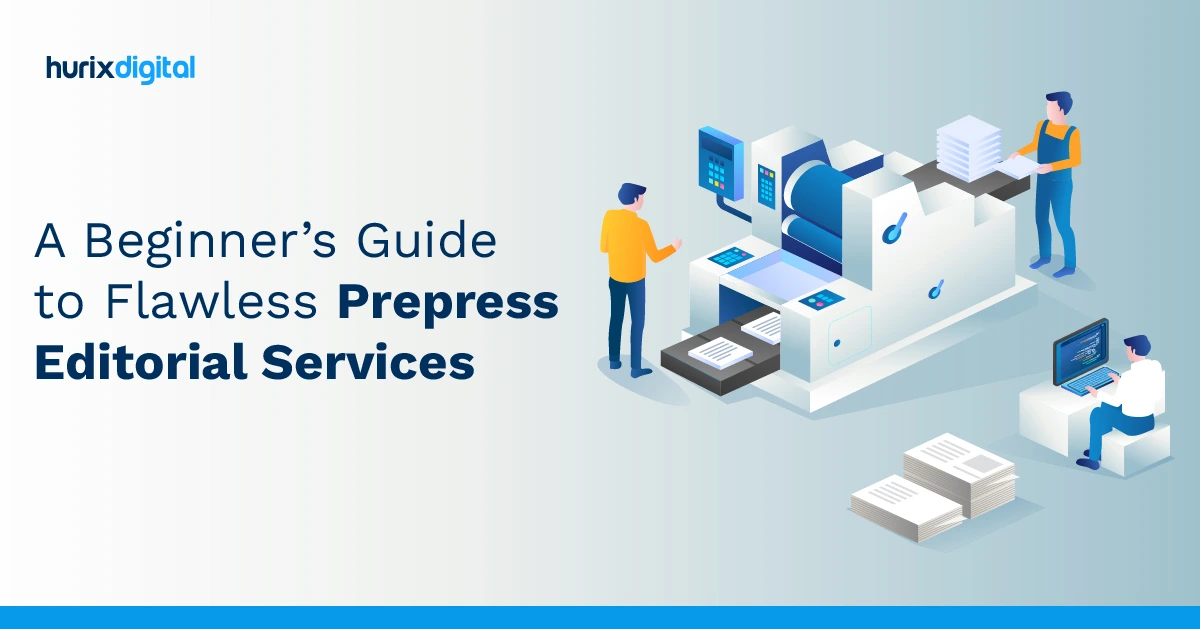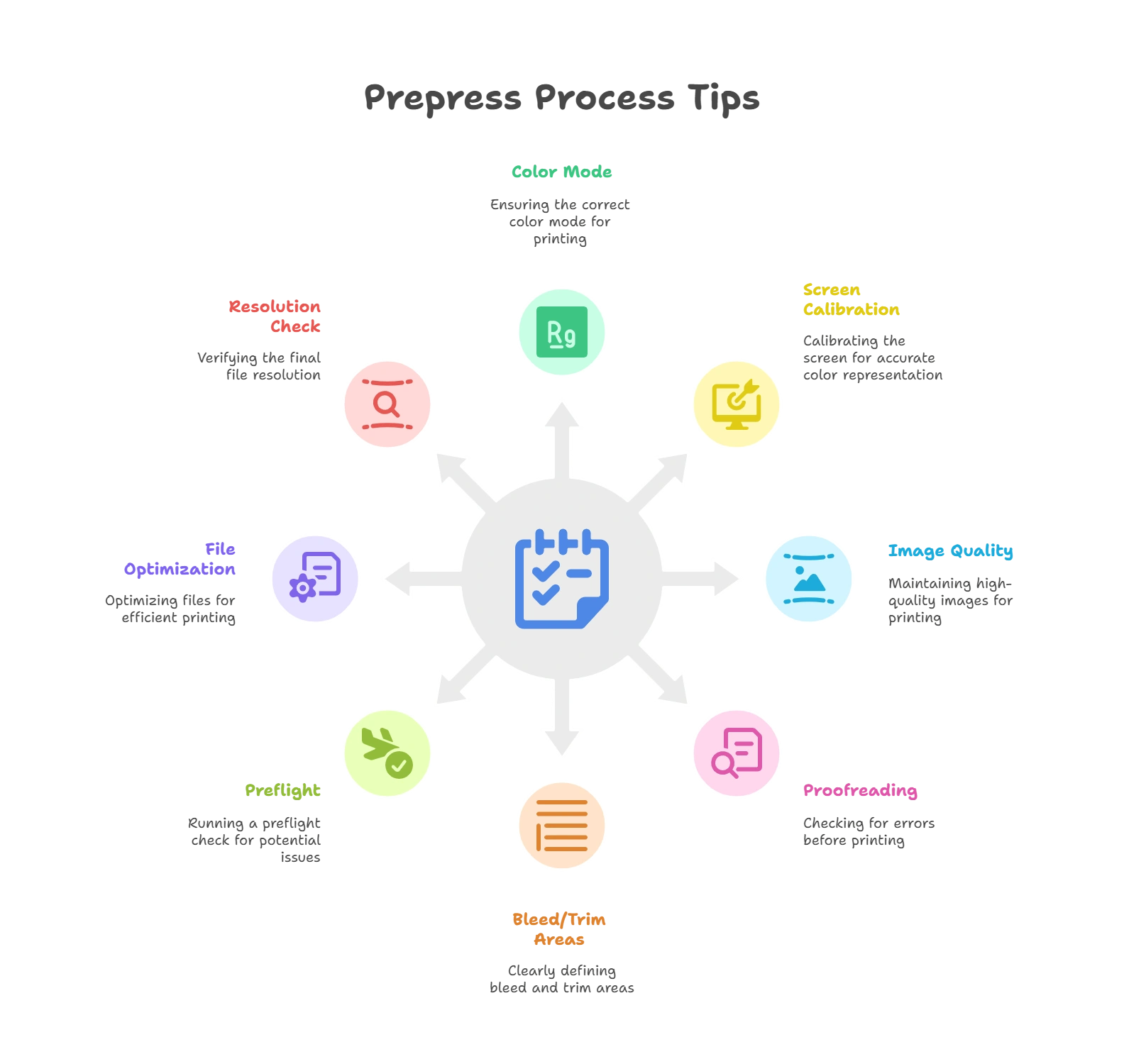
A Beginner’s Guide to Flawless Prepress Editorial Services
Summarize with:
The traditional publishing process is complex and cumbersome. Over the years, technology has revolutionized the workflow by automating several processes. However, the demands of content creation have significantly evolved due to various consumer shifts. One way to free up more bandwidth and drive results is to outsource the entire editorial function. Businesses can leverage prepress editorial services from specialists with extensive experience in marrying technological innovation with a deep understanding of the editorial process.
In this blog, we get into the upcoming market challenges and how companies can benefit through prepress editorial services.
Table of Contents:
- What are Prepress Processes?
- Key Prepress Challenges in the Market
- 10 Excellent Tips for Prepress Process
- Work with the Right Color Mode
- Check the Color Mode on Your Design Suite
- Calibrate the Screen You are Working On
- Simulate CMYK Colors on the Monitor
- Image Quality and Size Matter
- Don’t Forget to Proofread
- Demarcate the Bleed/Trim Areas Clearly
- Run a Preflight
- Optimize Your Files for Printing
- Check the Resolution of the Final File
- Outsourcing Prepress Editorial Services
- How to Choose a Specialist?
- Impact of Outsourcing Prepress Tasks
- The Takeaway
What are Prepress Processes?
Publishers are continuously looking to simplify the workflow in their production operations. Leveraging prepress editorial services can significantly simplify this process.
These services cover a spectrum of tasks and responsibilities associated with content production before it is ready for publishing.
The shift to digital content has triggered the evolution of digital prepress, which is replacing the traditional ways of producing pages for printing. Here is a snapshot of the main key prepress tasks:
- Copyediting ensures that the content is presented in an accurate, engaging, and optimized manner.
- Typesetting comprises designing layouts using various design applications. It also includes touching up images and finalizing them.
- Proofreading is a necessary step to ensure an error-free copy. Aspects like formatting and other types of errors are also corrected.
- The text needs to be digitally structured for the final presentation using a text-coding system called Display. This is done using Markup language, which gives instructions about how the text of the document or book will be displayed.
- Publishers need to ensure that all data meets the printer’s requirements. For instance, high-resolution PDFs are required to produce high-quality print copies.
Key Prepress Challenges in the Market
Today, specific types of publishers, such as those producing books, journals, textbooks, and periodicals, are facing a host of challenges, as follows:
- A massive amount of existing content needs to be upgraded to make it interactive and stay relevant. However, publishers may not have taken the able solutions to infuse interactivity into their products.
- Publishers are looking to make their content more relevant to a wider demographic, including senior consumers, those with mobility and learning limitations, and consumers facing language barriers.
- Prepress editorial processes can also be manual in nature and hence, be time-consuming. Editorial teams may not have the know-how to leverage technology to expedite processes and produce error-free, optimized digital content at scale.
This is where the support of specialist prepress editorial services can help publishers bring efficiency and cost-effectiveness to their operations via a tech-enabled and outcome-focused solution to the table.

10 Excellent Tips for Prepress Process
Prepress and pilot runs are necessary to ensure that your publishing material turns out the way you want on paper or other screens. The Pre-press process can be broadly divided into two major categories:
- Working with colors
- Working with the text and composition
We will cover some handy tips for both categories.
1. Work with the Right Color Mode
Traditionally, publishers used the CMYK (Cyan, Magenta, Yellow, and Key/Black) color mode for all printing purposes (printers require CMYK codes to print on paper). This color mode isn’t as bright and saturated as the standard RGB (Red, Green, and Blue) that monitors use today.
Publishers and designers today choose to work with RGB to truly reflect the character of print and design. With the advent of digital editorial and pre-press solutions, it has become possible to correctly translate RGB colors to CMYK while retaining the vibrance of the design.
2. Check the Color Mode on Your Design Suite
Publishers are spoilt for choice with the availability of software that aids design and digital publishing. However, each software comes with its default configurations in color mode.
For example, Adobe suites follow the Standard RGB. In addition, some solutions by pre-press services may have their design platforms set to CMYK as their default color mode.
Before you begin working on your publishing design, always check which color mode the design suite is set to. Working with RGB and then translating it to CMYK allows you to achieve excellent color translation that appears vibrant despite being on paper.
3. Calibrate the Screen You are Working On
Electronic screens use light as a medium to display colors (much like printers that use ink). So, regardless of what color palette your design and publishing suites are set to, your screens display the colors they are calibrated for.
Ensure that you regularly check whether your screen is calibrated to the standard configurations of RGB (or CMYK, if that is what you are working with). Modern computers allow you to calibrate screen color modes, so it shouldn’t be difficult.
4. Simulate CMYK Colors on the Monitor
When working in the RGB color palette, you must periodically check your file for corresponding CMYK output to ensure that your design is translating as desired. Simulating the CMYK palette while designing helps you make adjustments as you go instead of piling up on you at the very end.
Many digital publishing platforms offer simulations, and this option is also available with Adobe’s design software (like InDesign).
5. Image Quality and Size Matter
It is a well-known fact that an image’s wrong size and resolution can make it look stretched out or cramped in, pixelated, or blown up in the final print. To avoid distorting the graphics in your design, ensure that the resolution and sizes you are using resonate well with the size of the document.
Good publishing is all about making sure everything fits and looks good as a unit.
6. Don’t Forget to Proofread
Proofreading is the one step you cannot skip over if you want to ensure that you publish a well-composed document. Proofreading involves checking for the correctness of the following aspects of your document:
- Typesetting
- Grammar and sentence structure
- Design and composition
- The flow of the content
Before entering the preflight phase of publishing, ensure that you have proofread your publishing material at least once.
7. Demarcate the Bleed/Trim Areas Clearly
Properly demarcate the bleed area and the trim marks for your design to ensure that you don’t expend more resources and time on a document than necessary for publishing.
The trim marks help to discern the boundaries of a layout, which aids in cropping the paper after printing. The bleed area highlights the parts of the design that appear on the screen but won’t be printed on the paper.
8. Run a Preflight
Preflight is a necessary step in pre-processing: it is like a practice run. The final draft of your layout is printed on paper to check whether the output is aligned with the requirements.
By running a preflight, you perform a final check before sending the files out for bulk printing. This helps you save on unnecessary expenses that would show up later as corrections if preflight is skipped.
9. Optimize Your Files for Printing
File optimization is the final step that helps you ensure that your print layout is as it should be. You can check the following aspects to help things run smoothly:
- Check whether the printer has all the resources needed to generate the print
- Print your final file as a high-resolution PDF with a laser printer
- Send all the images in the document separately, regardless of whether or not they are embedded
- The source file should contain all the typesetting information that the printer can process
10. Check the Resolution of the Final File
The final file to the printer should be set to high-resolution PDF printing. You must check these settings on your pre-press suite and your printers.
The resolutions should be aligned to avoid image distortion and printing errors.
Outsourcing Prepress Editorial Services
Today, publishers can outsource the entire prepress editorial operations to a specialist. Publishers can outsource workflow as a whole or some aspects of it. Here is a rundown of popular prepress editorial services:
- Full-service project management: This entails the complete end-to-end management of a project, covering all aspects of the prepress editorial services.
- Pre-editing and copy editing services for eBooks, including formatting, cleaning up, hyperlinking, styling, and indexing of content
- Backend XML conversion services that enable conversion of eBooks existing with multiple DTDs (Document Type Definition) and schemes, with utilities developed for the project
- Artwork and designs, which entail adding illustrations and edited images to the final pages before publishing
- Typesetting by using relevant design software to design superior layouts for the content
How to Choose a Specialist?
Publishing eBooks and other content formats involves several stakeholders, including authors, production teams, and consumer lists.
Manual coordination takes up an extensive amount of time, reducing efficiency. Specialists who offer prepress editorial services understand these challenges and leverage tech-enabled, automated solutions to streamline all aspects of the process.
Their team brings a mix of editorial, design, publishing skills, and tech-savviness to help customize solutions.
Impact of Outsourcing Prepress Tasks
Here is a snapshot of the potential impact:
- Reduction of manual processes, which take up extensive time for publishing teams. By outsourcing these functions, a team member can instead understand their markets and be more invested in content development and business strategy.
- The use of technology brings down costs and saves time.
- Another key outcome is the superior quality of content, which is produced to enhance its readability. Better layouts, high-quality images, and text placement are key deliverables.
- With interactive eBooks becoming more popular, publishers can offer embedded videos, animations, audio, and hyperlinks to improve engagement. This is a valuable enhancement for all kinds of books, from travel stories to children’s books and science textbooks.
The Takeaway
The benefit of outsourcing prepress editorial services is that publishers have great flexibility in deciding how much to outsource and how much to keep in-house. Your prepress partner will work collaboratively to add value to the process and keep pace with digital content trends.
However, your chosen partner offering prepress editorial services must not merely be an editorial process specialist. They must essentially be an innovative technology company that offers tech-enabled solutions.
Such a partnership ensures that all the tech and editorial gaps are plugged in. This will be an ongoing journey because consumers will keep involved, and publishers will need to keep evolving.
If your business is looking to revamp its prepress services, Hurix Digital is geared to support you in meeting all your company’s content creation needs.
Get in touch with us to start a conversation.
Summarize with:

Vice President – Content Transformation at HurixDigital, based in Chennai. With nearly 20 years in digital content, he leads large-scale transformation and accessibility initiatives. A frequent presenter (e.g., London Book Fair 2025), Gokulnath drives AI-powered publishing solutions and inclusive content strategies for global clients
 Upcoming Masterclass | Build an Army of Brand Evangelists using Training & Development | November 20th, 8:30 AM PDT | 11:30 AM EDT | 10:00 PM IST
Upcoming Masterclass | Build an Army of Brand Evangelists using Training & Development | November 20th, 8:30 AM PDT | 11:30 AM EDT | 10:00 PM IST





